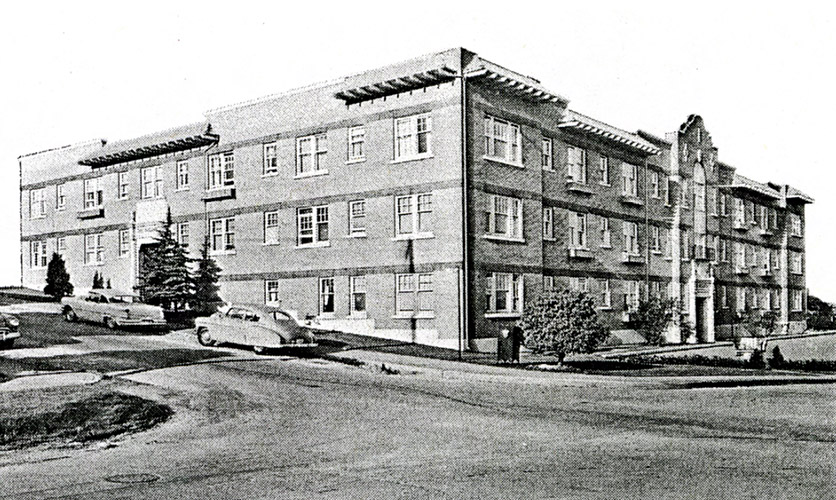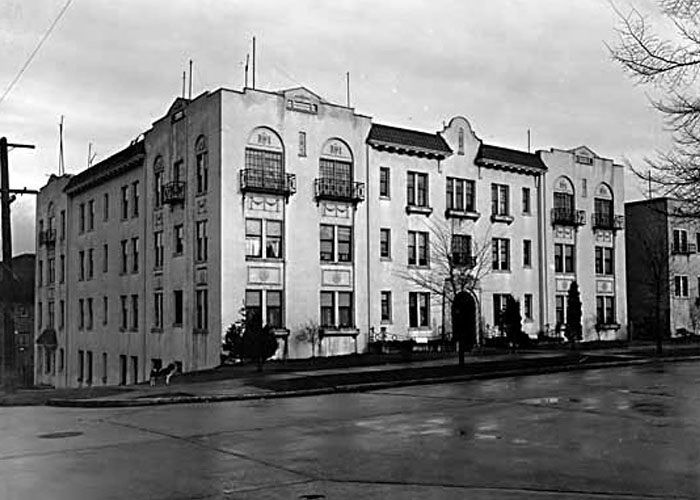The Equitable Real Estate Investment Corporation manages an impressive portfolio of Vancouver’s buildings. The stories of these landmark structures reflect the city’s own historical development, as well as its boom and bust economy. They represent a century of progress, and continue as a proud reminder of the past and a continuing legacy for the future.
Two of Vancouver’s most prominent office buildings – the Vancouver Block and the Rogers Building – were constructed during the height of the Edwardian era. These handsome terra cotta-clad ‘skyscrapers’ are both located on Granville Street and were completed in 1912, symbolizing the rising fortunes and stature of the city in the midst of its greatest economic boom. It was the time when British investment in western Canada was at its height, with rampant speculation on the bright future promised by the imminent opening of the Panama Canal. Vancouver was widely noted for having the tallest commercial buildings in the British Empire, just two decades after the City had been founded.
Equitable’s two other commercial buildings, the Duncan Building and the P. Angela Webster Building were also completed in 1912. These buildings were all built just before the economic collapse of 1913, which was followed by the outbreak of the First World War. Vancouver’s economy did not recover until a slow and cautious economic expansion began in the early 1920s.
As the economy began to recover in the ‘Roaring Twenties’, many new residential buildings were constructed to meet the demands of a growing population. New apartment districts in the West End, Kitsilano and South Granville signalled a new, denser form of development, providing enviable living accommodations in highly desirable locations, with a number of suites occupied by returning veterans. These new neighbourhoods were built on existing streetcar lines but some residents were beginning to acquire automobiles, which were just becoming common. Some of these apartment blocks, including the Brambly Apartments on West 15th Avenue and the Wellington Apartments on Trafalgar Street, are neighbourhood landmarks, valued for their richly detailed designs that demonstrated the high level of architectural sophistication in post-war Vancouver.
The onset of the Great Depression, following the 1929 stock market crash, halted much of the new construction that was underway. Times were tough in the first half of the ‘Dirty Thirties’, and Canada lacked the massive recovery programs that were underway in the United States. However, as the economy improved in the latter half of the decade, an increasing number of new apartment buildings were designed and completed in the city, taking advantage of the reduced cost of labour and materials. One of these buildings, the Tudor Revival-style Chateau Apartments on West 13th Avenue, completed in 1936, was a notably luxurious building for its time, and remains one of South Granville’s most prized residential addresses today.
Why not enjoy the personalized service and comfort provided in one of these Equitable operated buildings in choice locations?
As the Second World War tore through Europe and Asia, Vancouver felt the impact of restricted domestic construction and shortages of labour and materials. Despite wartime restrictions, Vancouver’s population was booming due to the coastal deployment of troops, which put significant pressure on the existing housing stock. By the mid-1940s, apartment blocks were being built and existing houses were being converted into multi-family units and rooming houses. Immediately after the War ended, there was a pent-up demand for new housing, and new apartments offered the most modern amenities and represented the simplified, forward-thinking design aesthetic of the time. Neighbourhoods such as South Granville were significantly densified, with buildings such as the Margaret Rose Apartments, designed by prominent local architect Ross A. Lort and completed in 1940. Cambie Street was also quickly being built up with many new streamlined buildings, such as the modernistic Warren Apartments. The postwar era ushered in a new age of peace, prosperity and growth that had not been seen for several decades.
The following is a historic quote from an advertisement for the Margaret Rose Apartments:
A modern apartment block in Vancouver’s most desirable location – close to the excellent South Granville shopping and bus service – yet off the main traffic – quiet and dignified. Spacious bachelor and 1-bedroom suites at very moderate rents ranging from $65.00 to $100.00 per month. Carpeted hallways – hardwood floors throughout – ample closet space – electric kitchen ranges and refrigerators – tiled Pembroke bathrooms – fully automatic oil heating – lockers for every suite – laundry and drying room – covered parking.
As the postwar economy continued to accelerate in the ‘Nifty Fifties’, Vancouver responded to rapid change by embracing the new modern Atomic Age. Zoning changes in the West End ushered in new high-rises and an unprecedented urban density, fundamentally transforming the single-family neighbourhood to a high-density apartment district. New, sleek, modern apartment buildings promised a contemporary lifestyle, and some – such as Equitable’s Bel Air Apartments and Brentwood Apartments – remain sought-after addresses nearly 60 years after their completion. Equitable’s youngest building, the Park Lane Apartments in North Vancouver, was completed in 1957, and has been offering prestigious accommodation ever since.
The following is a historic quote from an advertisement for the Bel Air Apartments:
A modern reinforced concrete apartment block – de luxe 1-bedroom and spacious bachelor suites – penthouse with magnificent view. Rents ranging from $82.50 to $175.00 per month. Hardwood floors throughout – colored plumbing – individual refrigerators – electric ranges – ample closet space – fully-automatic 3-point outside heating control. Carpeted halls – fully automatic elevator – modern laundry and drying room – fully automatic washing machine and dryer – lockers for every suite – underground garage – electrically operated overhead doors. Excellent West End location near Stanley Park and Lost Lagoon – close to bus line and Denman shopping.
Vancouver has changed immensely since the 1960s, as it successfully transitioned from a provincial centre of commerce to a bustling global city with global aspirations. Expo 86 marked Vancouver’s appearance on the world stage, with millions of visitors arriving to enjoy the fair and the city. During this time period, Equitable significantly increased its portfolio, beginning with the Vancouver Block, and eventually growing to 4 downtown office buildings and 28 residential buildings.
As the Vancouver Block, Rogers Building, Duncan Building and P. Angela Webster Building have celebrated their 100th birthdays in 2012, their position in Vancouver has been enhanced by the recent renovation to Granville Street and other streetscape improvements throughout downtown. These buildings remain as stately as the day they opened. Interior improvements to the Vancouver Block and the Rogers Building are uncovering and restoring beautiful original high-quality finishes, and this ongoing work celebrates and marks their prime position as commercial rental space. These ‘century’ buildings have placed Equitable in the venerable position of managing some of Vancouver’s most precious heritage buildings.
The successful management of these buildings, plus the 29 residential properties in the Equitable portfolio, have provided offices and apartments for generations of local businesses and residents, and provides an impressive legacy for the next era of Vancouver’s history.








